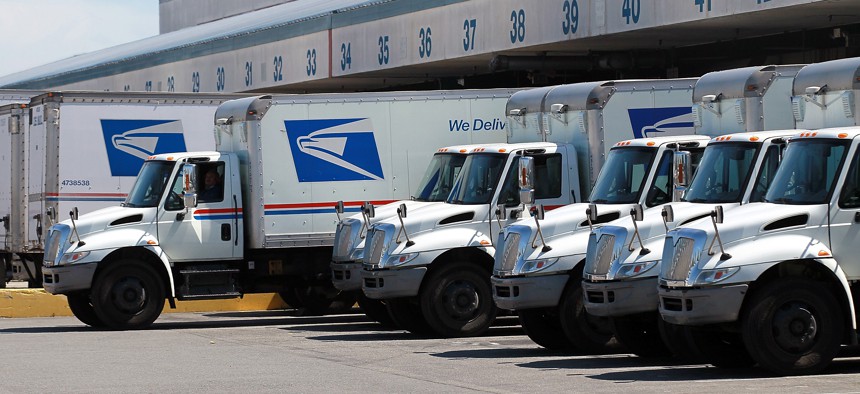
Justin Sullivan/Getty
The Nationwide Trucker Shortage Has Hit the Postal Service
Recruiting and retaining both its own drivers and contractors is a big challenge.
For the past week, a group of truckers known as the “Freedom Convoy” has circled the Capital Beltway outside Washington, and begun to venture into the city. Perhaps some of the truckers might consider stopping off and filing a job application at the U.S. Postal Service while they’re in town. USPS, like other employers of truckers, is looking to hire.
“The ongoing national truck driver shortage is…hugely consequential to postal operations,” the Postal Service inspector general’s office recently reported. USPS has been short about 1,000 drivers in its Postal Vehicle Service for several years. The vehicle service, along with private-sector suppliers in USPS’s Highway Contract Route system, handles mail between postal facilities that are less than 300 miles apart. Long-haul routes of more than 300 miles are handled exclusively by HCR contractors.
So far, the vehicle shortage hasn’t had an impact on service, postal officials say. But it has put more stress on the existing trucking workforce. Officials at the American Postal Workers Union reported that overtime has dramatically increased since the start of the Covid-19 pandemic.
On the contract route side, postal officials told the IG there has been an uptick recently in what they call “omitting service”—failure to fully provide the level of service outlined in their contracts. At the same time, the costs of contracting have increased. Payments for long-haul trucking services increased by nearly 20% in fiscal 2021, to almost $3 billion.
The National Star Route Mail Contractors Association said the difficulty of recruiting and retaining truck drivers has been a key factor in the cost increases. It has also led to a rise in the number of suppliers giving up their contracts because they can’t make a profit on them.
The cost of hiring and retaining truck drivers may make it difficult for the Postal Vehicle Service to meet its workforce needs. But while it’s difficult for USPS to match private sector salaries, its employment policies can work to its advantage. For example, postal trucking schedules are predictable and consistent. Also, under union labor agreements, drivers must be given two consecutive days off per week. Likewise, USPS contracts with suppliers offer more predictable schedules than are typically found in private industry.
Other factors besides pay and scheduling can adversely affect driver retention. Things as simple as access to bathrooms and amenities at loading facilities can make a difference. Trucking contractors told the IG that “drivers are instructed at some Postal Service facilities to wait by their vehicle and do not have access to restrooms within the facility. They also noted specific instances of [contract route] drivers waiting in lines outside facilities without access to bathrooms in November and December 2020, during peak season.”
The total pool of contractors USPS works with has declined by about a third since 2018. Postal officials said they are working to expand the number of contractors by bringing in new commercial trucking companies that don’t have prior experience serving USPS. But requirements that contractors pay their employees locally prevailing wages, along with security and equipment requirements, can make it difficult for the Postal Service to compete with private companies for trucking services.







